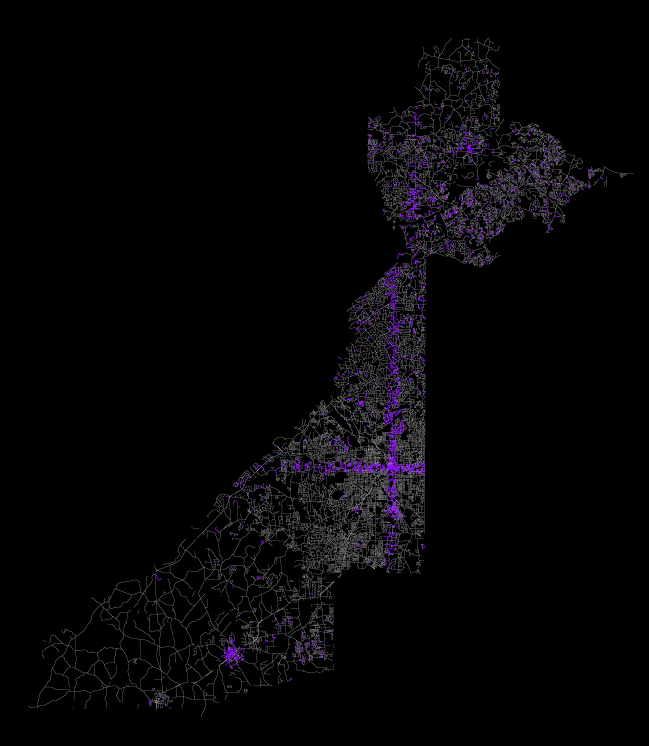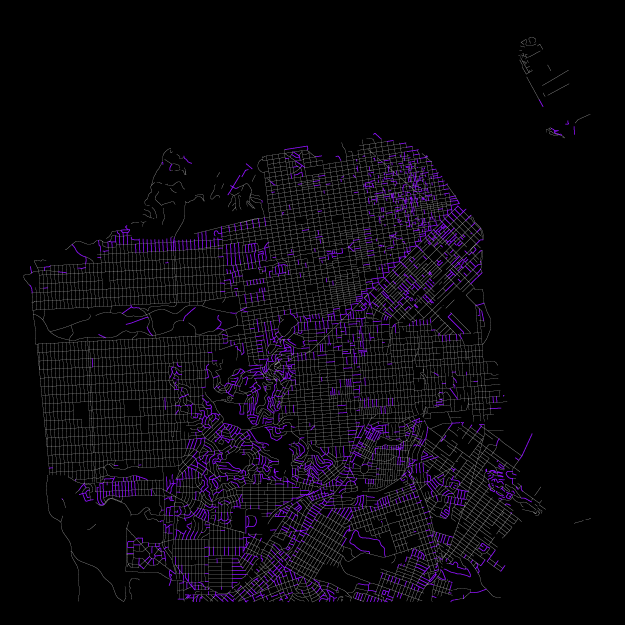Paint by numbers
Here’s something from the “Mildly Interesting” files. Address numbering schemes can vary a lot from place to place in the United States. In some cities the system is straightforward enough that by knowing a street number you can know approximately, if not exactly, the location of that address. In some other places… well, luckily addresses are all geocoded and easy to search for these days.
Beyond knowing the system or finding addresses, I was curious to see complete house numbering systems. I had ideas of colorful city maps representing street numbers from low to high, but my attempts failed to produce anything worthwhile because the range of numbers tends to be so great that it’s difficult to show patterns of any intricacy.
Instead, one can still get a sense of the house numbering scheme by looking at where the numbers begin. So I made a few maps to show that, based on the Census Bureau’s TIGER/Line files. Here are seven cities (the counties that contain them, actually, because that’s how the Census rolls), obviously not an extensive set nor likely representative, but showing a bit of variety. Purple blocks are those containing any numbers from 1 to 100.
Washington, DC: A perfect example of a system where numbers increase in north, south, east, and west directions from two central axes, in this case extending from the Capitol. In Washington’s case, the city is divided into quadrants. Chicago is another very orderly big city, but my computer is too weak to handle a map of all the streets in Cook County.

Atlanta: Atlanta is similarly divided into quadrants, but here streets are not as geometrically perfect, and I’m not sure if the axes always follow particular streets (or other features).

Dayton, Ohio: Had to check out my place of origin. Dayton bases its numbers not strictly on cardinal directions but (mostly) on the main north-south and east-west streets, which bend a bit. Meanwhile, the rural parts of Montgomery County appear to follow the same pattern, while individual towns do their own thing.

New Orleans: I can’t really tell what’s going on here. There is the north-south divide on Canal Street, but I can’t discern what the baseline for other streets might be. Any locals out there who can explain?

Manhattan: Another well-organized system, with numbers counting upward from 5th Avenue (and Central Park, it looks like) and from downtown. Unlike many other places with gridded, numbered streets, the addresses don’t match the cross street number, not that you can see that in this map. I vaguely recall once seeing some kind of formula for determining which block a given address is on. Any links or confirmation would be wonderful!

San Francisco: What the hell? Wikipedia says there are different numbering systems within the city. You wacky left-coasters.

Boston: I’m not saying things are so much neater over here. Boston and presumably much of New England keep it simple. Numbers just count upward from the beginning of the street, wherever that may be. (I’m not actually sure which end of the street is favored for the beginning; I know my street in Cambridge starts from the north.) Being the jumbled mess that it is, Boston doesn’t have a whole lot of streets that are longer than a couple of blocks, hence a mostly purple map.

Is this what taxi drivers’ brains look like?
Tagged street numbers

18 Comments